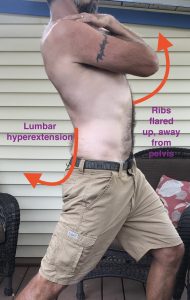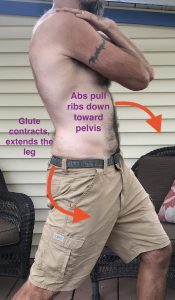I’ve written several times about my problems with Achilles tendinopathy and plantar fasciits. I’ve also written an article about cramping. My solution has been to strengthen the lower legs for the Achilles problem, and strengthen the adductors and hamstrings to fix the cramping. I think the strength work has helped, but there’s more to the story.
A few weeks ago I attended a running seminar with Jay Dicharry, a physical therapist and running/cycling coach. It was a superb course and I got to revisit some biomechanics and running technique concepts to which I’d been exposed in the past.
We discussed stacking the ribs over the pelvis while running. This posture helps take pressure off the lumbar spine and it puts the pelvis in a position to optimize the use of muscles that attach to the pelvis, especially the glutes. This posture enables a runner to use the glutes to propel the runner forward which is an efficient way to run in that the gluteus maximus is the largest muscles in the body.
I realized during this discussion that though my running technique had improved, I could improve it a little more. Specifically, I saw that I wasn’t using my glutes enough to run and as a consequence, I was using my calves and probably my adductors (which extend the hip along with the hamstrings and glutes) too much. Forward propulsion wasn’t being distributed evenly among these muscles. The glutes weren’t doing their fair share to create hip extension and the abs weren’t helping maintain good pelvic position. The calves and adductors were doing too much work. The overexertion was causing excessive strain on the Achilles and plantar fascia, and causing early fatigue of the adductors which led to cramps.
I believe I can also trace my ~10 years of low-back pain to this faulty running technique. Again, my lack of glute contribution demanded that I use lumbar extension to get my leg behind me.

This position brought on low-back pain, hamstring/adductor cramps, and Achilles/foot pain.
I’ve been running a little differently lately. I’ve become more aware of where my ribs are positioned in relation to my pelvis. I’ve also tuned in to my glutes. I work to feel them contract to push me forward. I’m aware of my ribs being stacked over my pelvis as I run.

This position is better for me. I’m stronger, more efficient, and I don’t hurt. The glutes and abs are doing their job.
This isn’t the first time in my fitness career that I’ve reexamined something I thought I understood only to realize I’d missed something significant. Coming back to information like this is similar to reading a good book a second time in that I see the same information in a different way. This second exposure to core and glute function expanded my understanding tremendously.
